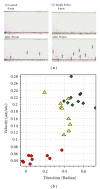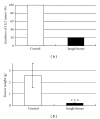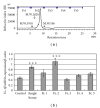Jungle honey enhances immune function and antitumor activity - PubMed (original) (raw)
Jungle honey enhances immune function and antitumor activity
Miki Fukuda et al. Evid Based Complement Alternat Med. 2011.
Abstract
Jungle honey (JH) is collected from timber and blossom by wild honey bees that live in the tropical forest of Nigeria. JH is used as a traditional medicine for colds, skin inflammation and burn wounds as well as general health care. However, the effects of JH on immune functions are not clearly known. Therefore, we investigated the effects of JH on immune functions and antitumor activity in mice. Female C57BL/6 mice were injected with JH (1 mg/mouse/day, seven times intra-peritoneal). After seven injections, peritoneal cells (PC) were obtained. Antitumor activity was assessed by growth of Lewis Lung Carcinoma/2 (LL/2) cells. PC numbers were increased in JH-injected mice compared to control mice. In Dot Plot analysis by FACS, a new cell population appeared in JH-injected mice. The percent of Gr-1 surface antigen and the intensity of Gr-1 antigen expression of PC were increased in JH-injected mice. The new cell population was neutrophils. JH possessed chemotactic activity for neutrophils. Tumor incidence and weight were decreased in JH-injected mice. The ratio of reactive oxygen species (ROS) producing cells was increased in JH-injected mice. The effective component in JH was fractionized by gel filtration using HPLC and had an approximate molecular weight (MW) of 261. These results suggest that neutrophils induced by JH possess potent antitumor activity mediated by ROS and the effective immune component of JH is substrate of MW 261.
Figures
Figure 1
Induction of new cell populations of PC by Jungle honey. (a) Control. (b) Jungle honey. (c) Isolated cell population. (d) Isolated cell population.
Figure 2
Enhancement of chemotactic activity for neutrophils by Jungle honey. (a) Image of neutrophil chemotaxis. (b) Dot plots of velocity and direction of neutrophils. Up arrow: Migrated cells, filled circle: control, filled diamond: fMLP (10−6 M), filled triangle: JH (1 mg/mL).
Figure 3
Inhibition of the incidence of LL/2 tumor (a) Tumor weight (a) by Jungle honey.
Figure 4
Histological findings of LL/2 tumor by Jungle honey. (a) Control. (b) Jungle honey.
Figure 5
Increases of ROS production in PC by Jungle honey. Open square: O2 −, filled square: H2O2.
Figure 6
Enhancement of IL-1_β_ mRNA expression in PC by Jungle honey fractions. (a) Fraction by gel filtration. (b) IL-1_β_ mRNA expression.
Similar articles
- Larval juvenile hormone treatment affects pre-adult development, but not adult age at onset of foraging in worker honey bees (Apis mellifera).
Elekonich MM, Jez K, Ross AJ, Robinson GE. Elekonich MM, et al. J Insect Physiol. 2003 Apr;49(4):359-66. doi: 10.1016/s0022-1910(03)00020-9. J Insect Physiol. 2003. PMID: 12769989 - Reproduction in worker honey bees is associated with low juvenile hormone titers and rates of biosynthesis.
Robinson GE, Strambi C, Strambi A, Huang ZY. Robinson GE, et al. Gen Comp Endocrinol. 1992 Sep;87(3):471-80. doi: 10.1016/0016-6480(92)90055-o. Gen Comp Endocrinol. 1992. PMID: 1426950 - Juvenile hormone enhances aversive learning performance in 2-day old worker honey bees while reducing their attraction to queen mandibular pheromone.
McQuillan HJ, Nakagawa S, Mercer AR. McQuillan HJ, et al. PLoS One. 2014 Nov 12;9(11):e112740. doi: 10.1371/journal.pone.0112740. eCollection 2014. PLoS One. 2014. PMID: 25390885 Free PMC article. - Insect juvenile hormone: from "status quo" to high society.
Hartfelder K. Hartfelder K. Braz J Med Biol Res. 2000 Feb;33(2):157-77. doi: 10.1590/s0100-879x2000000200003. Braz J Med Biol Res. 2000. PMID: 10657056 Review. - Juvenile hormone in adult eusocial Hymenoptera: gonadotropin and behavioral pacemaker.
Robinson GE, Vargo EL. Robinson GE, et al. Arch Insect Biochem Physiol. 1997;35(4):559-83. doi: 10.1002/(SICI)1520-6327(1997)35:4<559::AID-ARCH13>3.0.CO;2-9. Arch Insect Biochem Physiol. 1997. PMID: 9210289 Review.
Cited by
- Effects of three types of Japanese honey on full-thickness wound in mice.
Nakajima Y, Nakano Y, Fuwano S, Hayashi N, Hiratoko Y, Kinoshita A, Miyahara M, Mochizuki T, Nishino K, Tsuruhara Y, Yokokawa Y, Iuchi T, Kon Y, Mukai K, Kitayama Y, Murakado N, Okuwa M, Nakatani T. Nakajima Y, et al. Evid Based Complement Alternat Med. 2013;2013:504537. doi: 10.1155/2013/504537. Epub 2013 Jan 20. Evid Based Complement Alternat Med. 2013. PMID: 23401714 Free PMC article. - The Immunomodulatory Effects of Honey and Associated Flavonoids in Cancer.
Masad RJ, Haneefa SM, Mohamed YA, Al-Sbiei A, Bashir G, Fernandez-Cabezudo MJ, Al-Ramadi BK. Masad RJ, et al. Nutrients. 2021 Apr 13;13(4):1269. doi: 10.3390/nu13041269. Nutrients. 2021. PMID: 33924384 Free PMC article. Review. - Enhancement of neutrophil chemotaxis by trans-anethole-treated Staphylococcus aureus strains.
Kwiatkowski P, Tabiś A, Sobolewski P, Płaziński W, Pruss A, Sienkiewicz M, Dołęgowska B, Wojciechowska-Koszko I. Kwiatkowski P, et al. PLoS One. 2023 Apr 7;18(4):e0284042. doi: 10.1371/journal.pone.0284042. eCollection 2023. PLoS One. 2023. PMID: 37027379 Free PMC article. - Pathway of 5-hydroxymethyl-2-furaldehyde formation in honey.
Yang W, Zhang C, Li C, Huang ZY, Miao X. Yang W, et al. J Food Sci Technol. 2019 May;56(5):2417-2425. doi: 10.1007/s13197-019-03708-7. Epub 2019 Apr 6. J Food Sci Technol. 2019. PMID: 31168124 Free PMC article. - Honey as a Potential Natural Antioxidant Medicine: An Insight into Its Molecular Mechanisms of Action.
Ahmed S, Sulaiman SA, Baig AA, Ibrahim M, Liaqat S, Fatima S, Jabeen S, Shamim N, Othman NH. Ahmed S, et al. Oxid Med Cell Longev. 2018 Jan 18;2018:8367846. doi: 10.1155/2018/8367846. eCollection 2018. Oxid Med Cell Longev. 2018. PMID: 29492183 Free PMC article. Review.
References
- Takeuchi M, Kimoto M, Suzuki I, Nomoto K. Effect of BCG sensitization on the generation of tumor specific killer T cells. Japanese Journal of Cancer. 1993;10:1980–1986. - PubMed
- Nakajima A, Ishida T, Koga M, Takeuchi T, Mazda O, Takeuchi M. Effect of hot water extract from Agaricus blazei Murill on antibody-producing cells in mice. International Immunopharmacology. 2002;2(8):1205–1211. - PubMed
- Qiu PY, Ding HB, Tang YK, Xu RJ. Determination of chemical composition of commercial honey by near-infrared spectroscopy. Journal of Agricultural and Food Chemistry. 1999;47(7):2760–2765. - PubMed
- Weston RJ, Brocklebank LK. The oligosaccharide composition of some New Zealand honeys. Food Chemistry. 1999;64(1):33–37.
- Stinson EE, Subers MH, Petty J, White JW., Jr. The composition of honey. V. Separation and identification of the organic acids. Archives of Biochemistry and Biophysics. 1960;89(1):6–12. - PubMed
LinkOut - more resources
Full Text Sources
Other Literature Sources





